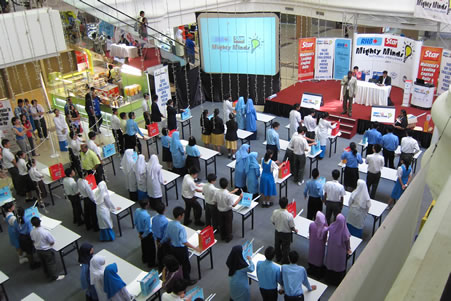English | Dutch |
|
| Mighty Minds | |
Kuantan (Malaysia), May 1st 2011
|
|
| |
|
On a Saturday we visit the Berjaya shopping mall in Kuantan, a city on the eastside of Malaysia. The open, central part of the mall is filled with people. For a moment, it looks like the product presentation of the new iPhone 4 is on the way, but when we get closer we see that a competition called “Mighty Minds” is being held. Dressed in school uniforms, delegated secondary school teams of Pahang State are competing to be crowned “Mightiest Mind” of their state. The competition is a kind of knockout race. In the beginning there are 60 teams of which 75 percent is eliminated after a series of multiple choice questions about math and science subjects. Parents and grand parents have gathered around the competition area to support their children and grand children. |
|
 |
|
A science quiz for secondary school students in a shopping mall in Kuantan |
|
In between the various parts of the competition, the head of the jury gives some insight about what is important in a good education. Knowledge, knowledge and knowledge supplemented with a large doses of creativity and the ability to think for your self. Creativity is tested in the next part of the competition in which the remaining 15 teams compete. Within one and a half hours, the students must build a model with limited supplied materials. Some must build a retractable terrace roof while others must build a parking deck with a control system made of led lights to regulate the car flow. The enthusiasm of the children is contagious. For a moment we try to imagine how this competition would look like, if it was held in a Dutch shopping mall. Participants would almost certainly be seen as nerds and there would be a limited number of competitors that want to sacrifice their free Saturday to compete in a competition like this. In Kuantan, the jury is looking how the children are working. It looks orderly; nobody is yelling of screaming. The group process isn’t an evaluation point; in this part of the game it is the result that counts. After one and a half hours, all students have to leave the competition area and the jury starts to evaluate the models. Most are looking quite nice, while some are already falling apart. While the results are being processed, the head of the jury wants to share his general impression of the models that have been created. We expect a typical Dutch, political correct, speech that compliments the groups processes of all groups and that notes that it was very difficult to choose between all those good models. This speech is different, however. He just speaks his mind and tells the contestants that the models were very disappointing, creativity is too low and that they all lack the skills to build a decent model. It’s an impassioned plea to work on these skills. The teams are being called upon to work at this assignment at home to create a good model to exhibit at their schools. The children and supporters are listening and nodding. It really seems as if they feel the responsibility to make their schools proud. Nobody complains about these harsh words and everybody takes this criticism seriously, even on a free Saturday. | |
 |
|
Mixed groups (boys and girls) is no problem in Malaysia |
|
| The five teams that eventually pass on to the next round are going berserk. The next assignment is to present their models. The whole contest is in English, and the children also have to give their presentation in English. After the presentations, the persons of team that has most points are being evaluated individually and the winner is being crowned the “mightiest mind” of Pahang. While we are following the contest, we get the feeling that Malaysian students (and Asian students in general) have much more ambition than their Dutch counterparts. Certainly, there are many Malaysian youngsters that prefer going to a karaoke box instead of competing in such a competition, but they still look up to smart, hard studying people. The Dutch school system emphasises on communicative and commercial skills and managerial qualities, while the Asians have a clear list of priorities that are reflected in the contest. First, they focus on knowledge while creativity is the next priority and communication skills follow later. The assertive and commercial mindset of the Dutch has been very important in the past, but in the end we also need knowledge. A country filled with managers who have only other managers to manage, is doomed in the globalising world. Innovation that can strengthen our competitiveness isn’t only driven by creativity, but also fed by knowledge, knowledge and more knowledge. In Asia, they feel this urgency and the children are eager to comply with this. In the future, our Dutch youngsters will have to compete with their Asian counterparts and if we don’t want to fight a losing battle, we have to make learning sexy again. A contest like this one in Kuantan can be a way to bring back the enthusiasm for maths and science subject. The time for soft talk is gone, to compete with the Asians we have to start working! | |